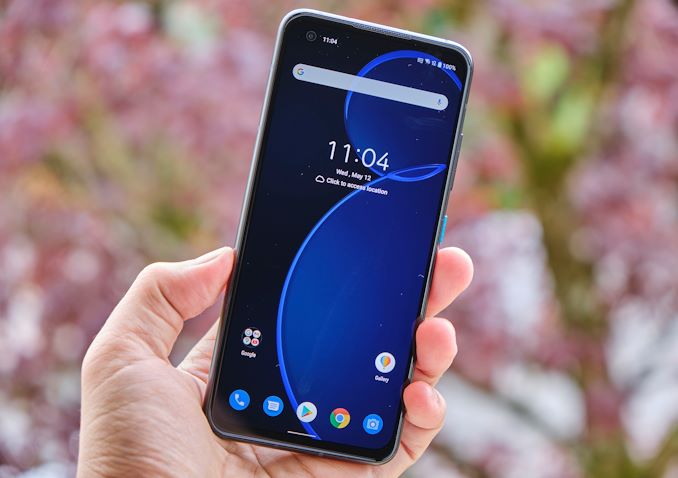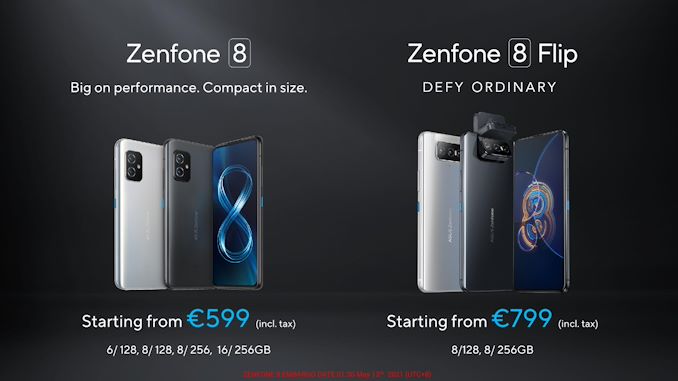The ASUS Zenfone 8 Hands-On Review: A New Compact Direction
by Andrei Frumusanu on May 12, 2021 1:30 PM EST- Posted in
- Smartphones
- Asus
- Mobile
- Zenfone 8
Conclusion & First Impressions
Today’s launch of the Zenfone 8 series is an interesting attempt by ASUS to position themselves in a gap in the market. The focus is clearly on the new Zenfone 8 which introduces as new smaller form-factor, and in many ways, it’s a unique device in the market because of that.
ASUS’s efforts in creating a smaller flagship phone work out well in terms of the actual form-factor and ergonomics of the Zenfone 8. The phone it actually reminded me the most of is the Pixel 5, both petite devices of similar dimensions, with the Zenfone 8 of course being built of more premium materials and having higher grade hardware components.
The display at 5.9” lands at a sweet-spot in terms of density for the 2400 x 1080 resolution. While we didn’t cover the matter in a dedicated section, I was actually impressed by the quality of the image calibration of the phone, allowing for near perfectly balanced white colour temperature in the settings, something many vendors struggle with. The 120Hz refresh rate of the panel is also great for general responsiveness of the device – however it comes at a cost of battery life.
While the phone has a 4000mAh battery, generally you can only expect good results in the 60Hz mode as like with many other devices this year, the Zenfone 8 features odd power consumption regressions. The 60Hz mode in turn comes at a cost of a regression of user experience that isn’t nearly as fluid as the 120Hz mode.
Performance of the phone is adequate, however aspects such as the sustained GPU and gaming performance of the phone, while adequate, isn’t the best due to the heavier throttling of such a smaller device.
Finally, there’s the cameras, and much like on the Zenfone 7 last year, it can be a deal-breaker for potential buyers. The camera hardware as well as the image processing just aren’t up to par with the competition. While the cameras are functional, they are well behind any competitor solution.
As we always say, there’s no bad product, just bad prices. In that regard, ASUS prices the Zenfone 8 at a very competitive 599€ starting price, which is far below the positioning of similarly specced competitors. The thing is though, is that while ASUS positions itself as a cheaper alternative, it also comes with quite a lot of drawbacks and compromises. Amongst the “small-phone” crowd, there’s really only the Xperia 5 III which isn’t available yet and comes at an eye-water 922€, or simply the Galaxy S21 which can be had today at 680€ - more expensive than the Zenfone 8, but also a vastly better device.
The Zenfone 8 Flip is quoted to start at 799€. Due to the meagre improvements of the Snapdragon 888 this year I would rather just advise to consider the Zenfone 7 at only 432€ right now if you’re after the flip-camera design, given that all other features and specifications between these two phones are the same.
Finally, there’s the continued issue of availability and limited releases depending on country and markets. I had asked ASUS about their recent track-record of having extremely slow roll-outs, with users sometimes waiting months to be able to purchase the phones in their specific region or country. Similarly, the Zenfone 8 series don’t have any concrete sell date or more specific pricing beyond the European start prices showcased in the above slide. ASUS had replied that they’re aiming to do better this year, but again shying away from disclosing any more concrete per-country availability information.
In that context, given the lack of availability dates as well as obvious better value competitor devices, it’s hard to recommend the new Zenfone 8 series phones – the company still has a lot of work ahead of it if it wants to be a contender in the mobile market.












66 Comments
View All Comments
shabby - Wednesday, May 12, 2021 - link
If no sdcard is available then the storage options should be increased, 256gb isn't enough.The galaxy s10 had a 1tb option and it still had an sdcard.
Boopop - Thursday, May 13, 2021 - link
I've been using a Sony XZ1 Compact for the past three years, without much of an issue. 256gb would be plenty for me, this ASUS phone is appealing. Just because 256gb is not enough for you it doesn't mean it's the case for everyone.Boopop - Thursday, May 13, 2021 - link
(which only has 32GB of storage, without an SD card).shabby - Thursday, May 13, 2021 - link
Some people just don't use their phones to their full capabilities 🤷🏼♂️I have 55gb of apps, 30gb of photos and 90gb of videos.
hemedans - Thursday, May 13, 2021 - link
i have xz1 compact too, and it does have sd card, where did you get yours without sd card?nico_mach - Wednesday, May 19, 2021 - link
If you never install an SD card, then it doesn't have an SD card.;-)
drajitshnew - Thursday, May 13, 2021 - link
I already have have 100+GB. And I don't take 4k videos because of storage anxietyBedfordTim - Thursday, May 13, 2021 - link
It is all about the trade offs at the price, but it is certainly a major limitation in terms of what you can do with the phone.notb - Tuesday, May 25, 2021 - link
Good thesis, bad logic.A successful product is not a product that SOMEONE will like. It's a product that many people will like.
Asus is pretty good at making niche phones that almost no one buys. So the question is: when (if ever) they start to focus on smartphone business as something they want to have an important role in (as in laptops). For now they're merely notifying their existence.
Linustechtips12#6900xt - Thursday, May 13, 2021 - link
as a galaxy s10e user this looks like a great upgrade, other than the no wireless charging bt otherwise very very compelling for me honestly